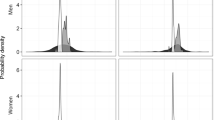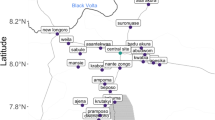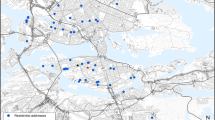Abstract
Background
Personal exposure to fine particulate matter (PM2.5) from household air pollution is well-documented in sub-Saharan Africa, but spatiotemporal patterns of exposure are poorly characterized.
Objective
We used paired GPS and personal PM2.5 data to evaluate changes in exposure across location-time environments (e.g., household and community, during cooking and non-cooking hours), building density and proximity to roadways.
Methods
Our study included 259 sessions of geolocated, gravimetrically-calibrated one-minute personal PM2.5 measurements from participants in the GRAPHS Child Lung Function Study. The household vicinity was defined using a 50-meter buffer around participants’ homes. Community boundaries were developed using a spatial clustering algorithm applied to an open-source dataset of building footprints in Africa. For each GPS location, we estimated building density (500 m buffer) and proximity to roadways (100 m buffer). We estimated changes in PM2.5 exposure by location (household, community), time of day (morning/evening cooking hours, night), building density, and proximity to roadways using linear mixed effect models.
Results
Relative to nighttime household exposure, PM2.5 exposure during evening cooking hours was 2.84 (95%CI = 2.70–2.98) and 1.80 (95%CI = 1.54–2.10) times higher in the household and community, respectively. Exposures were elevated in areas with the highest versus lowest quartile of building density (FactorQ1vsQ4 = 1.60, 95%CI = 1.42–1.80). The effect of building density was strongest during evening cooking hours, and influenced levels in both the household and community (31% and 65% relative increase from Q1 to Q4, respectively). Being proximal to a trunk, tertiary or track roadway increased exposure by a factor of 1.16 (95%CI = 1.07–1.25), 1.68 (95%CI = 1.45–1.95) and 1.27 (95%CI = 1.06–1.53), respectively.
Impact
-
Household air pollution from cooking with solid fuels in sub-Saharan Africa is a major environmental concern for maternal and child health. Our study advances previous knowledge by quantifying the impact of household cooking activities on air pollution levels in the community, and identifying two geographic features, building density and roadways, that contribute to maternal and child daily exposure. Household cooking contributes to higher air pollution levels in the community especially in areas with greater building density. Findings underscore the need for equitable clean household energy transitions that reach entire communities to reduce health risks from household and outdoor air pollution.
This is a preview of subscription content, access via your institution
Access options
Subscribe to this journal
Receive 6 print issues and online access
$259.00 per year
only $43.17 per issue
Buy this article
- Purchase on Springer Link
- Instant access to full article PDF
Prices may be subject to local taxes which are calculated during checkout



Similar content being viewed by others
Data availability
The datasets generated during and/or analyzed during the current study are not publicly available because this analysis included geolocated information considered to be personally identifiable information (PII). However, the authors have created a GitHub repository demonstrating the development of community boundaries as well as estimating surrounding building density and nearby roadways using a simulated GPS trajectory [https://github.com/dmedgyesi/GeospatialGhana].
References
Bennitt F, Wozniak S, Causey K, Burkart K, Brauer M. Estimating disease burden attributable to household air pollution: new methods within the Global Burden of Disease Study. Lancet GlobHealth 2021;9:18.
Cohen AJ, Brauer M, Burnett R, Anderson HR, Frostad J, Estep K, et al. Estimates and 25-year trends of the global burden of disease attributable to ambient air pollution: an analysis of data from the Global Burden of Diseases Study 2015. Lancet. 2017;389:1907–18.
HEI Household Air Pollution–Ghana Working Group. Contribution of Household Air Pollution to Ambient Air Pollution in Ghana. Health Effects Institute 2019; Communication 19. Boston, MA, USA. WA754R432.
Adhikari S, Mahapatra PS, Pokheral CP, Puppala SP. Cookstove Smoke Impact on Ambient Air Quality and Probable Consequences for Human Health in Rural Locations of Southern Nepal. Int J Environ Res Public Health. 2020;17:550.
Downward GS, Hu W, Rothman N, Reiss B, Wu G, Wei F, et al. Outdoor, indoor, and personal black carbon exposure from cookstoves burning solid fuels. Indoor Air. 2016;26:784–95.
Weaver AM, Gurley ES, Crabtree-Ide C, Salje H, Yoo EH, Mu L, et al. Air pollution dispersion from biomass stoves to neighboring homes in Mirpur, Dhaka, Bangladesh. BMC Public Health. 2019;19:425.
Clougherty JE, Wright RJ, Baxter LK, Levy JI. Land use regression modeling of intra-urban residential variability in multiple traffic-related air pollutants. Environ Health. 2008;7:17.
Fuks KB, Weinmayr G, Basagaña X, Gruzieva O, Hampel R, Oftedal B, et al. Long-term exposure to ambient air pollution and traffic noise and incident hypertension in seven cohorts of the European study of cohorts for air pollution effects (ESCAPE). Eur Heart J. 2017;38:983–90.
Requia WJ, Koutrakis P. Mapping distance-decay of premature mortality attributable to PM2.5-related traffic congestion. Environ Pollut. 2018;243:9–16.
Baumgartner J, Zhang Y, Schauer JJ, Huang W, Wang Y, Ezzati M. Highway proximity and black carbon from cookstoves as a risk factor for higher blood pressure in rural China. Proc Natl Acad Sci. 2014;111:13229–34.
Ni K, Carter E, Schauer JJ, Ezzati M, Zhang Y, Niu H, et al. Seasonal variation in outdoor, indoor, and personal air pollution exposures of women using wood stoves in the Tibetan Plateau: Baseline assessment for an energy intervention study. Environ Int. 2016;94:449–57.
Carter E, Archer-Nicholls S, Ni K, Lai AM, Niu H, Secrest MH, et al. Seasonal and Diurnal Air Pollution from Residential Cooking and Space Heating in the Eastern Tibetan Plateau. Environ Sci Technol. 2016;50:8353–61.
Van Vliet ED, Asante K, Jack DW, Kinney PL, Whyatt RM, Chillrud SN, et al. Personal exposures to fine particulate matter and black carbon in households cooking with biomass fuels in rural Ghana. Environ Res. 2013;127:40–48.
Lai AM, Clark S, Carter E, Shan M, Ni K, Yang X, et al. Impacts of stove/fuel use and outdoor air pollution on chemical composition of household particulate matter. Indoor Air. 2020;30:294–305.
Chillrud SN, Ae-Ngibise KA, Gould CF, Owusu-Agyei S, Mujtaba M, Manu G, et al. The effect of clean cooking interventions on mother and child personal exposure to air pollution: results from the Ghana Randomized Air Pollution and Health Study (GRAPHS). J Expo Sci Environ Epidemiol. 2021;31:683–98.
Jack DW, Ae-Ngibise KA, Gould CF, Boamah-Kaali E, Lee AG, Mujtaba MN, et al. A cluster randomised trial of cookstove interventions to improve infant health in Ghana. BMJ Glob Health. 2021;6:e005599.
Bofah RO, Appiah-Konadu P, Ngwu FN. Transition to cleaner cooking energy in Ghana. Clean Energy. 2022;6:957–66.
Lee AG, Kaali S, Quinn A, Delimini R, Burkart K, Opoku-Mensah J, et al. Prenatal Household Air Pollution Is Associated with Impaired Infant Lung Function with Sex-Specific Effects. Evidence from GRAPHS, a Cluster Randomized Cookstove Intervention Trial. Am J Respir Crit Care Med. 2018;199:738–46.
Quinn AK, Ae-Ngibise KA, Jack DW, Boamah EA, Enuameh Y, Mujtaba MN, et al. Association of Carbon Monoxide exposure with blood pressure among pregnant women in rural Ghana: Evidence from GRAPHS. Int J Hyg Environ Health. 2016;219:176–83.
Quinn AK, Ae-Ngibise KA, Kinney PL, Kaali S, Wylie BJ, Boamah E, et al. Ambulatory monitoring demonstrates an acute association between cookstove-related carbon monoxide and blood pressure in a Ghanaian cohort. Environ Health. 2017;16:76.
Boamah-Kaali E, Jack DW, Ae-Ngibise KA, Quinn A, Kaali S, Dubowski K, et al. Prenatal and Postnatal Household Air Pollution Exposure and Infant Growth Trajectories: Evidence from a Rural Ghanaian Pregnancy Cohort. Environ Health Perspec. 2021;129:117009.
Adams C, Riggs P, Volckens J. Development of a method for personal, spatiotemporal exposure assessment. J Environ Monit. 2009;11:1331–9.
Jack DW, Asante KP, Wylie BJ, Chillrud SN, Whyatt RM, Ae-Ngibise KA, et al. Ghana randomized air pollution and health study (GRAPHS): study protocol for a randomized controlled trial. Trials. 2015;16:420.
Carrión D, Prah R, Gould CF, Agbokey F, Mujtaba M, Pillarisetti A, et al. Using longitudinal survey and sensor data to understand the social and ecological determinants of clean fuels use and discontinuance in rural Ghana. Environ Res Commun. 2020;2:095003.
Daouda M, Mujtaba MN, Yang Q, Seyram K, Lee AG, Tawiah T, et al. Prediction of personal exposure to PM2.5 in mother-child pairs in rural Ghana. J Expo Sci Environ Epidemiol. 2022. https://doi.org/10.1038/s41370-022-00420-1.
Kaali S, Jack DW, Prah RKD, Chillrud SN, Mujtaba MN, Kinney PL, et al. Poor early childhood growth is associated with impaired lung function: Evidence from a Ghanaian pregnancy cohort. Pediatr Pulmonol. 2022;57:2136–46.
Chakrabarti B, Fine PM, Delfino R, Sioutas C. Performance evaluation of the active-flow personal DataRAM PM2.5 mass monitor (Thermo Anderson pDR-1200) designed for continuous personal exposure measurements. Atmos Environ. 2004;38:3329–40.
Arnold TB. leaderCluster: Leader Clustering Algorithm. R package version 1.2., 2014. https://CRAN.R-project.org/package=leaderCluster.
Sirko W, Kashubin S, Ritter M, Annkah A, Bouchareb YSE, Dauphin Y, et al. Continental-scale building detection from high resolution satellite imagery. arXiv 2021. https://arxiv.org/abs/2107.12283.
Open Buildings A dataset of building footprints to support social good applications. Google Research, Ghana 2021. https://sites.research.google/open-buildings/.
Density-Based Clustering Based on Hierarchical Density Estimates. Berlin, Heidelberg: Springer Berlin Heidelberg; 2013.
Ester M, Kriegel H-P, Sander J, Xu X. A density-based algorithm for discovering clusters in large spatial databases with noise. In: Proceedings of the Second International Conference on Knowledge Discovery and Data Mining. Portland, Oregon: AAAI Press; 1996. pp 226-31.
Hahsler M, Piekenbrock M, Doran D. dbscan: Fast Density-Based Clustering with R. J Stat Softw. 2019;91:1–30.
Gombin J, Vaidyanathan R, Agafonkin V. concaveman: A Very Fast 2D Concave Hull Algorithm. In: R package version 1.1.0., 2020.
Pebesma E. Simple Features for R: Standardized Support for Spatial Vector Data. R J. 2018;10:439–46.
Poplawski K, Gould T, Setton E, Allen R, Su J, Larson T, et al. Intercity transferability of land use regression models for estimating ambient concentrations of nitrogen dioxide. J Expo Sci Environ Epidemiol. 2009;19:107–17.
Amini H, Taghavi M, Naddafi K, Nabizadeh R, Yunesian M. Correlation of air pollutants with land use and traffic measures in Tehran, Iran: A preliminary statistical analysis for land use regression modeling. J Adv Environ Health Res. 2013;1:1–8.
Coker ES, Amegah AK, Mwebaze E, Ssematimba J, Bainomugisha E. A land use regression model using machine learning and locally developed low cost particulate matter sensors in Uganda. Environ Res. 2021;199:111352.
Padgham M, Rudis B, Lovelace R, Salmon M. osmdata. J Open Source Softw. 2017;2:305.
Kim-Blanco P, Cîrlugea B-M, de Sherbinin A. Quality assessment of crowd-sourced data: OpenStreetMap roads validation in the developing countries of West Africa. 2018. https://doi.org/10.13140/RG.2.2.28798.41287.
Herfort B, Lautenbach S, Porto de Albuquerque J, Anderson J, Zipf A. The evolution of humanitarian mapping within the OpenStreetMap community. Sci Rep. 2021;11:3037.
Baumann LM, Robinson CL, Combe JM, Gomez A, Romero K, Gilman RH, et al. Effects of distance from a heavily transited avenue on asthma and atopy in a periurban shantytown in Lima, Peru. J Allergy Clin Immunol. 2011;127:875–82.
Brugge D, Durant JL, Rioux C. Near-highway pollutants in motor vehicle exhaust: A review of epidemiologic evidence of cardiac and pulmonary health risks. Environ Health. 2007;6:23.
Samiksha S, Sunder Raman R, Nirmalkar J, Kumar S, Sirvaiya R. PM10 and PM2.5 chemical source profiles with optical attenuation and health risk indicators of paved and unpaved road dust in Bhopal, India. Environ Pollut. 2017;222:477–85.
Pachón JE, Galvis B, Lombana O, Carmona LG, Fajardo S, Rincón A, et al. Development and Evaluation of a Comprehensive Atmospheric Emission Inventory for Air Quality Modeling in the Megacity of Bogotá. Atmosphere. 2018;9:49.
Mikou M, Rozenberg J, Koks EE, Fox CJE, Peralta Quiros T. Assessing rural accessibility and rural roads investment needs using open source data. World Bank Policy Research Working Papers 2019. https://doi.org/10.1596/1813-9450-8746.
Takyi E, Mensah H, Aazore FK, Nalumu DJ, Abu JJ Understanding the Urban Planning-Green Space Depletion Nexus: Insights from the Kwabre East Municipality, Ghana. Urban Forum 2022; https://doi.org/10.1007/s12132-022-09471-x.
Diko SK, Hollstein LM. Towards an alternative interpretation of the socio-cultural dimensions of urban greenspace planning in the Global South: Evidence from the Kumasi Metropolis of Ghana. J Urban Aff. 2023;45:522–45.
Abass K, Appiah DO, Afriyie K. Does green space matter? Public knowledge and attitude towards urban greenery in Ghana. Urban Forestry Urban Green. 2019;46:126462.
Acknowledgements
The authors are grateful to the mothers and their children who participated in the study. The authors would also like to thank the community leaders in the study area for their support.
Funding
This work was supported by the National Institute of Environmental Health Sciences (NIEHS) Grants R01ES026991, P30ES009089, R01ES019547, R21HD094229, R01ES024489, R01ES034433, K23HL1353449, and T32ES007322.
Author information
Authors and Affiliations
Contributions
KPA, DNM, DWJ and SNC conceived of the work. MNM, SK, DWJ and SNC led the exposure assessment work. QY processed the data used in this analysis. All authors contributed to the design of the study. JP provided spatial analysis advice. DNM completed the analysis and drafted the manuscript. All authors contributed to the interpretation of results and revision of the manuscript.
Corresponding author
Ethics declarations
Competing interests
The authors declare no competing interests.
Ethical approval
The protocol for this study was approved by the Kintampo Health Research Center Institutional Ethics Committee, and the Institutional Review Board for Human Subjects Research at Columbia University Medical Center and Mount Sinai.
Additional information
Publisher’s note Springer Nature remains neutral with regard to jurisdictional claims in published maps and institutional affiliations.
Supplementary information
Rights and permissions
Springer Nature or its licensor (e.g. a society or other partner) holds exclusive rights to this article under a publishing agreement with the author(s) or other rightsholder(s); author self-archiving of the accepted manuscript version of this article is solely governed by the terms of such publishing agreement and applicable law.
About this article
Cite this article
Medgyesi, D.N., Mujtaba, M.N., Yang, Q. et al. Geospatial determinants of maternal and child exposure to fine particulate matter in Kintampo, Ghana: Levels within the household and community, by surrounding building density and near roadways. J Expo Sci Environ Epidemiol (2023). https://doi.org/10.1038/s41370-023-00606-1
Received:
Revised:
Accepted:
Published:
DOI: https://doi.org/10.1038/s41370-023-00606-1



